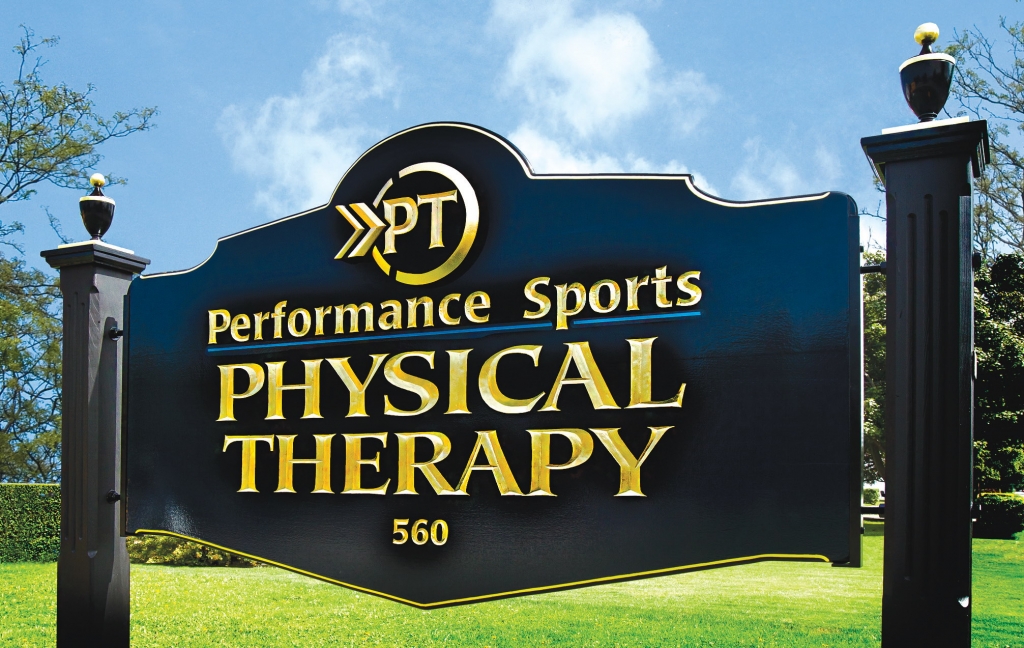For nearly two decades, I’ve been producing handcarved, gilded, wood-sign artistry. My son, Stephen, has handled my installations since the beginning. About 40% of that work has been devoted to fascia productions, which we discussed in “Facing Fascia Installations” (see ST, January 2010, page 46). Now, we’re ready to reveal our techniques for our more prolifically produced sign type: post-mounted signage.
Over the years, the mantra, “Necessity is the mother of invention,” has guided us. Thus, I’ve developed various procedures and devices to assist fabrication. First, I designed a wooden, calibratible installation jig to help us methodically determine precise, post-hole placement, as well as accurate post positioning once they’re in the holes.
The original, maple jig has evolved into two aluminum jigs – one for smaller panels, one for larger. Each jig provides two, adjustable slider platforms that sit atop of the posts. We calibrate the jig before an installation by measuring the panel and adding 15 in.
For instance, for a 60-in.-wide panel, we calculate 75 in. as the distance between the posts’ outside edges. To reach this figure, we add the 60-in. panel; 2 in. on either side of the panel; and each of the 5.5-in.-wide (nominally 6 in.) posts. We drill holes, as needed, in the jig to accommodate panels of various sizes.
We use the jig to indicate where the holes will be dug. When the holes are dug with the posts inserted, we place the jig atop the posts to create proper spacing and leveling. We then use dry-cement mix to firm up the posts. Eventually, groundwater mixes with the dry cement to produce a hard footing. At this point, we remove the jig.
To attach the panel to the posts, we designed channel brackets, which we customize for each new panel. At the base of each bracket is a “shoe,” on which we rest the weight of the panel during and after the installation. The brackets, which comprise rustproof baked and powdercoated aluminum, fit around the panel’s end-grain, which we pre-groove to fit the channel.
Advertisement
We affix the bracket to the panel with stainless-steel lag screws, and the brackets to the posts with threaded rods, which are welded to the brackets. The 6 x 6, treated posts have pre-drilled holes to accept the threaded rods, nuts and washers. We detail these posts with fluting, chamfering and round-overs (the subject of a future article), and, because they’re treated and don’t accept paint, we stain them twice with a solid-color sealant.
After we’ve attached the brackets to the panel and posts, the end result is a “floating” substrate. The panel doesn’t touch the posts; there’s a 2-in. gap between them. Keeping them separated helps prevent weathering problems. We also use the “floating” concept for panels while working in the studio and transporting them for installation.
Whether or not a panel is double-sided, we always attach two or more, custom-made steel “handles” to each panel’s end-grain while they’re in production. This technique allows us to flip or transport the panels without damage to the surface or protruding appliqués.
After the posts are installed, we clean the posts with water because they inevitably get dusty during the installation. Next, we apply another coat of stain to enhance the surface. Then, we apply touch-up paint to the hardware and a dab of silicone on the bracket tops, add our nameplate, and secure the finials and caps.
Finally, it’s time to photograph our work, and return to the computer to upload this sign to our website portfolio.
Equipment and Materials
Coating: Sikkens Cetol solid-color, exterior wood sealant, from Akzo Nobel Coatings (Flying Hill, PA), (610) 775-6640 or www.akzonobel.com; 1Shot lettering enamel, from One Shot LLC (Chicago), (773) 646-2778 or www.1shot.com
Hardware and Equipment: Powdercoated, aluminum brackets, fabricated by Signs of Gold; Post-hole digger, from home-improvement and building-supply stores; dry-cement mix, from home-improvement and building-supply stores; installation jig, fabricated by Signs of Gold; finials and caps, fabricated by Signs of Gold; stainless-steel lag screws, available from building-supply stores; steel panel-transport handles, fabricated by Signs of Gold; reciprocating saw, from home-improvement or building-supply stores;
Panel: Gilded, mahogany panels, fabricated by Signs of Gold
Advertisement
More about Francis
After a career in academia as a physics, chemistry, math and theology instructor, Francis returned to his love of the lettering arts and started Signs of Gold, Inc. with his son, Stephen, in 1994. Today, he serves on the board of the Society of Gilders. Each year, he joins the group in their pro-bono project – restoring gold artifacts in historic New Orleans churches that were destroyed by Hurricane Katrina.
Lestingi has earned first-, second- and third-place awards in ST’s Sign Contest and nine first-place awards from the United States Sign Council’s (USSC) sign-industry competition. Lestingi has also designed two calligraphic fonts, Pierre and Calileo, available through www.LetterheadFonts.com, and two other digital typefaces, FranHand and Stefano, which are available through www.MyFonts.com.



 Photo Gallery2 weeks ago
Photo Gallery2 weeks ago
 Ask Signs of the Times2 weeks ago
Ask Signs of the Times2 weeks ago
 Paula Fargo1 week ago
Paula Fargo1 week ago
 Real Deal5 days ago
Real Deal5 days ago
 Photo Gallery1 week ago
Photo Gallery1 week ago
 Women in Signs2 weeks ago
Women in Signs2 weeks ago
 Women in Signs2 weeks ago
Women in Signs2 weeks ago
 Projects5 days ago
Projects5 days ago







